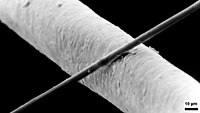
Photo from wikipedia
The temperature rise of fiber-reinforced polymer (FRP) composites caused by self-heating under cyclic loading significantly degrades the performance of composite structures during their service life. This study examines the cyclic… Click to show full abstract
The temperature rise of fiber-reinforced polymer (FRP) composites caused by self-heating under cyclic loading significantly degrades the performance of composite structures during their service life. This study examines the cyclic responses in FRP composites, incorporating the effect of energy dissipation from the viscoelastic polymeric matrix on the microscopic and macroscopic performance of FRP composites. FRP composite models that consist of unidirectional fibers randomly distributed in a polymeric matrix are generated. A thermo-viscoelastic constitutive material model, which accounts for the energy dissipation and heat generation, is considered for the polymeric matrix, while a linear elastic response is considered for the fibers. The effects of loading directions, fiber volume fractions, voids, and different thermo-rheological behaviors of the polymer, on the hysteretic responses of the FRP composites, at the macroscopic and microscopic scales, are examined. A wider microscopic hysteresis loop was observed as compared to the macroscopic response. After a few minutes of cyclic loading, the substantial reductions in the stress amplitude are observed, which is associated with the stress relaxation and accelerated relaxation from the heat generation. The surface temperature of the FRP model due to heat generation increases at first cycles and then stabilizes, as experimentally observed in the literature. For HDPE/AS4 carbon fiber composite, at a frequency of 1 Hz, up to 30 and 8% reduction in stress magnitude was observed under transverse and axial cyclic loadings, respectively. This study provides an assessment of reductions in the load-carrying capacity of FRP composites under cyclic loadings.
Journal Title: Journal of Materials Engineering and Performance
Year Published: 2020
Link to full text (if available)
Share on Social Media: Sign Up to like & get
recommendations!